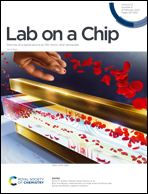A fully integrated SNP genotyping system for hereditary hearing-loss detection†
Abstract
Hereditary hearing loss is one of the most common human neurosensory disorders, and there is a great need for early intervention methods such as genetically screening newborns. Single nucleotide polymorphisms (SNPs) are the major genetic targets for hearing-loss screening. In this study, a fully integrated SNP genotyping system was constructed to identify hereditary hearing loss-related genetic markers from human whole blood. The entire detection process, including blood cell lysis, nucleic acid extraction, the reaction mixture distribution, the chambers sealing and the two-colour multiplex competitive allele-specific polymerase chain reaction (KASP), can be automatically conducted in a self-contained cassette within 3 hours. To critically evaluate the performance of the system, its specificity, sensitivity and stability were assessed. Then, 13 clinical samples were genotyped with this fluidic cassette system to detect seven hotspot deafness-associated mutations in three genes (MT-RNR1, GJB2 and SLC26A4). The detection results of the cassette system were 100% concordant with those obtained by Sanger sequencing, proving its accuracy in the genetic screening of inherited hearing loss.

- This article is part of the themed collection: Miniaturised Sensors & Diagnostics


 Please wait while we load your content...
Please wait while we load your content...